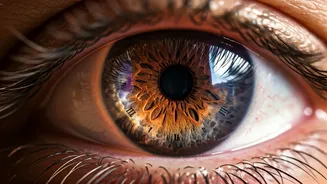Understanding Seasonal Sadness
Seasonal Affective Disorder (SAD), often referred to as 'winter blues,' is a type of depression linked to changes in seasons. It typically surfaces during
the fall and winter months when there's less sunlight. Though the exact cause of SAD is still being researched, experts think that it is connected with the body’s internal clock (circadian rhythm), changes in serotonin and melatonin levels. Shorter days disrupt this rhythm, potentially triggering mood shifts. Additionally, lower exposure to sunlight can lead to lower serotonin levels, a neurotransmitter that influences mood, and higher levels of melatonin, a hormone linked to sleepiness. These shifts collectively contribute to feelings of sadness, fatigue, and other symptoms associated with SAD. It is crucial to recognize that SAD is a recognized mood disorder, highlighting the importance of seeking help if the symptoms are severe or persistent. Many individuals experience a milder form of these seasonal mood changes, but persistent or debilitating symptoms warrant attention.
Recognizing Key Indicators
The symptoms of Seasonal Affective Disorder (SAD) can vary from person to person, but there are some common signs to watch out for. These include persistent feelings of sadness, low energy, and changes in sleep patterns, such as sleeping much more or having difficulty sleeping. Individuals with SAD often experience changes in appetite, often with cravings for carbohydrates, which can lead to weight gain. Social withdrawal, where someone avoids social activities and prefers to be alone, is also a frequently observed symptom. Difficulty concentrating, feeling hopeless, or having suicidal thoughts are severe indicators that require immediate attention. Recognizing these symptoms early can allow for prompt intervention and treatment, which is critical for managing SAD and improving the person's quality of life. It’s also crucial to remember that symptoms tend to recur each year at the same time and resolve with the change of seasons, thus, helping with diagnosis.
Light Therapy Benefits
Light therapy is a common treatment for Seasonal Affective Disorder (SAD). It involves exposing yourself to a special lamp that emits bright light, usually for 20-30 minutes each day. This light mimics natural sunlight, which is believed to help regulate the body's internal clock (circadian rhythm) and boost mood. The lamp should provide about 10,000 lux of light and has a special filter to remove harmful UV rays. Light therapy is typically used in the morning, which is the time of day when it is most effective. It's often recommended to sit or work near the lamp with your eyes open, but not to stare directly into it. When beginning light therapy, people usually start with short durations, slowly increasing the amount of time as needed. Many individuals find that light therapy significantly improves their mood and energy levels within a few weeks of beginning treatment. However, it's essential to consult a healthcare professional before starting light therapy to make sure it's appropriate for you and to minimize any potential side effects, such as headaches or eye strain. Light therapy is most effective when used in conjunction with other treatments, like psychotherapy or medication.
Embracing Lifestyle Adjustments
Besides light therapy, there are several lifestyle adjustments you can make to mitigate the effects of Seasonal Affective Disorder (SAD). Regular exercise, even a short walk outdoors, can increase mood and energy levels. Spending time outside, even on cloudy days, can help you get more natural light exposure. Maintaining a regular sleep schedule, where you go to bed and wake up at the same time each day, can help regulate your body's circadian rhythm. A balanced diet, rich in fruits, vegetables, and whole grains, will help improve your overall mood and health. Social engagement is also important; making time for social interactions and connecting with friends and family can alleviate feelings of isolation and loneliness. Other ways to counter the symptoms is to manage stress and practice relaxation techniques, like yoga or meditation. Consider these lifestyle adjustments as tools in your overall wellness strategy. Making these adjustments can significantly enhance your mood and overall quality of life.
Seeking Professional Guidance
If you are struggling with Seasonal Affective Disorder (SAD), reaching out to a mental health professional is important. A doctor or therapist can assess your symptoms, provide an accurate diagnosis, and recommend suitable treatments. Psychotherapy, particularly cognitive-behavioral therapy (CBT), is a very effective way to address negative thought patterns and behaviors that can exacerbate SAD symptoms. Antidepressant medications, such as selective serotonin reuptake inhibitors (SSRIs), may be prescribed to manage depression. Consulting with a mental health professional ensures that you receive the correct treatment and support, which can significantly improve your well-being. It's also important to follow all the treatment plan recommendations. Regular check-ins with your healthcare provider will help monitor the effectiveness of your treatment. Remember, seeking help is a sign of strength, and with the right support, you can successfully manage SAD and improve your quality of life.














